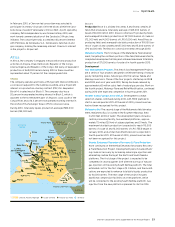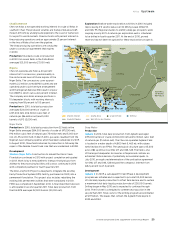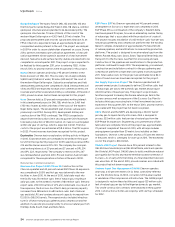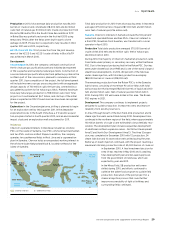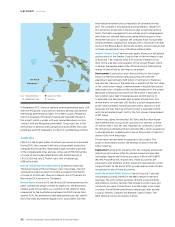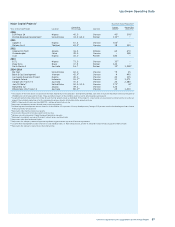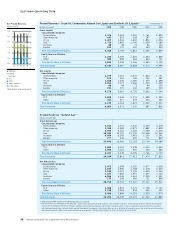Chevron 2010 Annual Report Download - page 32
Download and view the complete annual report
Please find page 32 of the 2010 Chevron annual report below. You can navigate through the pages in the report by either clicking on the pages listed below, or by using the keyword search tool below to find specific information within the annual report.
30 Chevron Corporation 2010 Supplement to the Annual Report
Exploration Two wells drilled in the Rokan Block in 2010 resulted
in discoveries and were placed on production. Appraisal drilling
near the Duri Field resulted in defining additional field expansion
opportunities to be further assessed by planned 3-D seismic
activity. A successful appraisal well was also drilled at the Bekasap
Field. During 2011, additional appraisal drilling is planned in the
Kulin and Bekasap fields.
East Kalimantan Chevron’s operated interests in Kalimantan
include four offshore PSC areas that cover approximately
2.8 million acres (11,100 sq km). The PSC areas are located offshore
East Kalimantan in the Kutei Basin, including operated interests
in East Kalimantan (92.5 percent), Makassar Strait (90 percent),
Rapak (80 percent) and Ganal (80 percent). In December 2010, the
company relinquished its interest in East Ambalat, located in the
Tarakan Basin offshore northeast Kalimantan. The relinquishment
is pending government approval, which is anticipated in the
second-half 2011.
In 2010, Chevron finalized an agreement to farm out an 18 percent
working interest in the Makassar Strait, Rapak and Ganal PSCs,
pending approval by the government of Indonesia, which is
expected in the second-half 2011. In addition, under the terms of
the Rapak and Ganal PSCs, the company is required to farm out to
an Indonesian partner, which would further reduce the company’s
ownership interest in Rapak and Ganal to 54 percent. The farm-
out to the Indonesian partner is expected to be completed by year-
end 2011. Once the government has approved these agreements,
the company’s share of production from the Gendalo-Gehem and
Bangka projects will be 55.1 percent and 54.0 percent, respectively.
Production Total daily production averaged 33,000 barrels of
crude oil (17,000 net) and 144 million cubic feet of natural gas
(104 million net) in 2010.
During 2010, the majority of Kalimantan production came from 14
producing fields in the shelf area within the East Kalimantan PSC.
The shelf area averaged 28,000 barrels of liquids (13,000 net)
and 113 million cubic feet of natural gas (78 million net). Crude oil
and natural gas produced from the northern fields are processed
at the company-operated Santan terminal and liquids extraction
plant. Natural gas is transported by pipeline to the state-owned
Bontang LNG plant and to a fertilizer, ammonia and methanol
complex. Crude oil and natural gas from the southern fields are
sent to the company-operated Lawe-Lawe terminal. The stored
crude oil is either exported by tanker or transported by pipeline to
the state-owned Balikpapan Refinery. The natural gas is transport-
ed by pipeline for use as fuel gas at the Balikpapan Refinery. The
East Kalimantan PSC expires in 2018.
The remaining production came from the deepwater West Seno
Field in the Makassar Strait PSC, with total daily production
averaging 5,000 barrels of liquids (4,000 net) and 31 million cubic
feet of natural gas (26 million net) in 2010. Products are separated
offshore in an FPU and are exported by dual subsea pipelines to
Santan Terminal. Crude oil is stored at Santan where it is exported
by tanker, and natural gas enters the existing Bontang infrastruc-
ture. The Makassar Strait PSC expires in 2020.
Development The company continues to implement projects
designed to sustain production, increase recovery and improve
reliability from existing reservoirs in both the shelf and deepwater
areas. In the shelf area, Chevron continued to execute the develop-
ment program with 22 new wells drilled in 2010. Based on the
positive results of the drilling program, additional seismic acquisi-
tion and processing is planned for the second-half 2011.
In addition, there are three deepwater development projects under
way. The Gendalo-Gehem natural gas project includes two separate
hub developments, each with its own FPU, subsea drill centers,
natural gas and condensate pipelines, and an onshore receiving
facility. In December 2010, the company awarded major FEED
contracts for the FPUs, the subsea and pipeline components, and
the onshore receiving facility. Completion of FEED is dependent
on government approvals and achievement of project milestones.
Maximum daily production from the project is expected to be 1.1
billion cubic feet of natural gas and 31,000 barrels of condensate.
Also in 2010, the Bangka Project development plan was advanced
and Chevron approved FEED in the fourth quarter. At the end of
2010, proved reserves had not been recognized for these projects.
The third development project is the Extended Reach Drilling
Project for the West Seno Field. The company reached a final
investment decision for the project in August 2010. Proved
reserves have been recognized for the project.
East Java Sea Basin
Exploration A third obligation well in the NE Madura III Block was
drilled in 2009 and resulted in a dry hole. Due to the results of this
well and the previously drilled exploration wells, the company
settled its obligation to participate in three additional exploration
wells and relinquished its 40 percent-owned and nonoperated
working interest in the PSC; government approval for the
relinquishment is anticipated in the second-half 2011.
West Papua In June 2010, Chevron received final government
approval to reduce its operated interest in two onshore exploration
blocks in western Papua to 51 percent. During the year, geologic
studies continued on West Papua I and West Papua III blocks, and
2-D seismic acquisition is expected to start in second quarter 2011.
South Natuna Sea Block B Chevron holds a 25 percent nonoper-
ated working interest in the offshore South Natuna Sea Block B.
Production Block B production is from seven natural gas fields and
four crude oil fields. Total daily production during 2010 averaged
75,000 barrels of liquids (9,000 net) and 421 million cubic feet of
natural gas (86 million net).
Development Block B has a five-phase development project to
support two long-term natural gas sales contracts with Malaysia
and Singapore. Drilling for the initial three development phases
continued through 2010. The North Belut Project, the fourth phase
of the Block B development, achieved first gas in 2009 and reached
a maximum total daily production of 240 million cubic feet of
natural gas and 33,000 barrels of liquids in February 2010.
Additional development drilling in the North Belut Field is planned
to continue through 2011.
Upstream Asia



